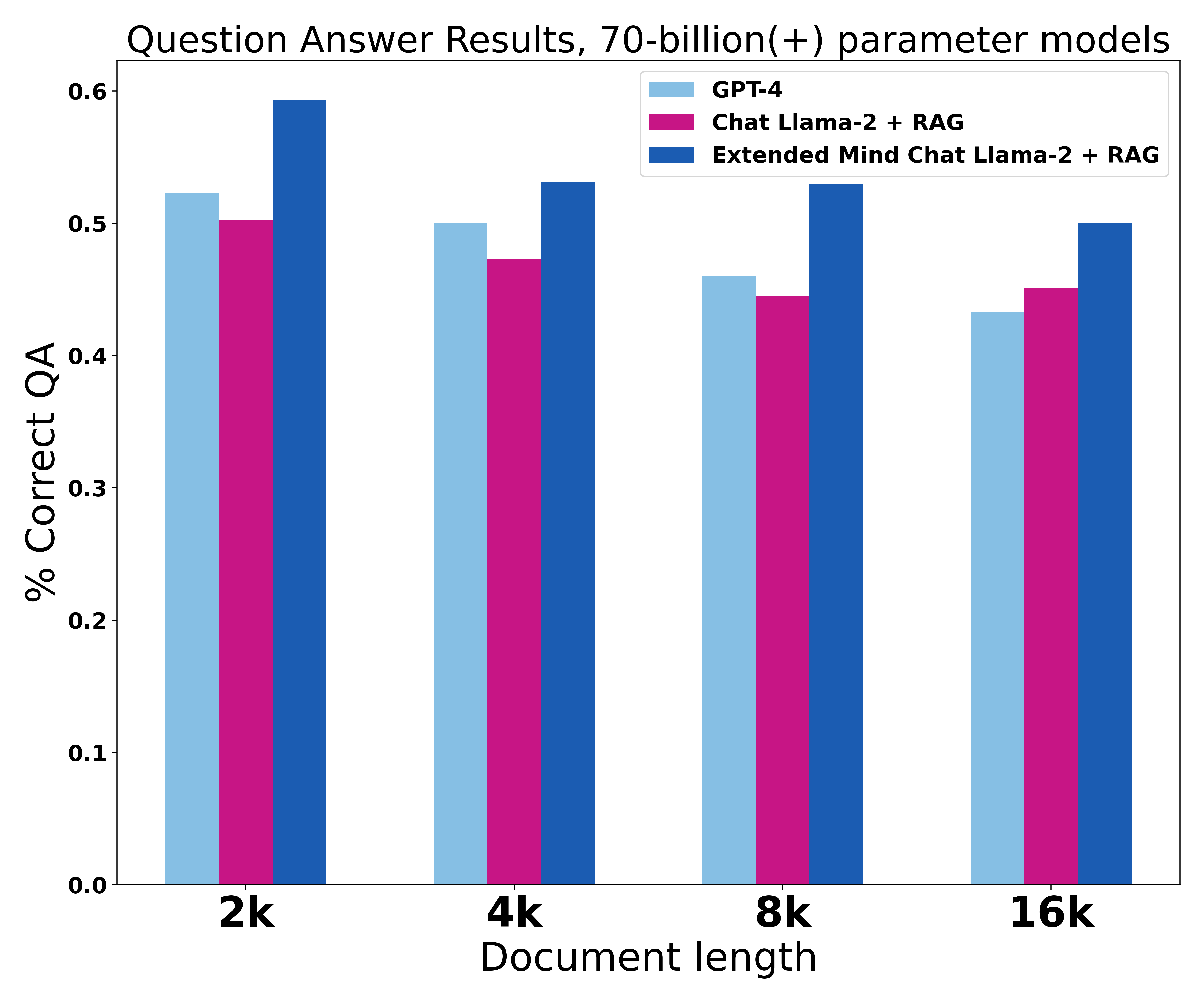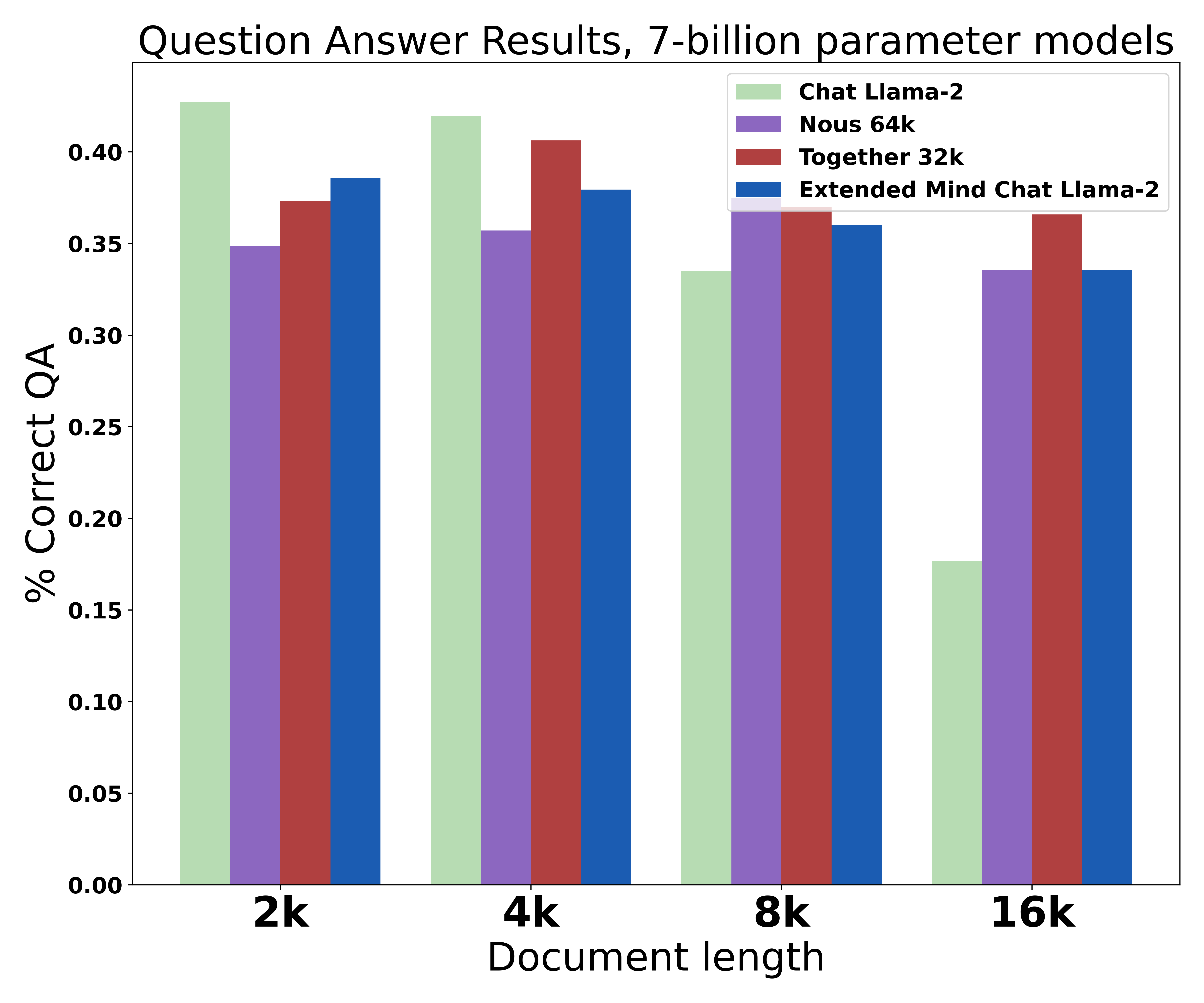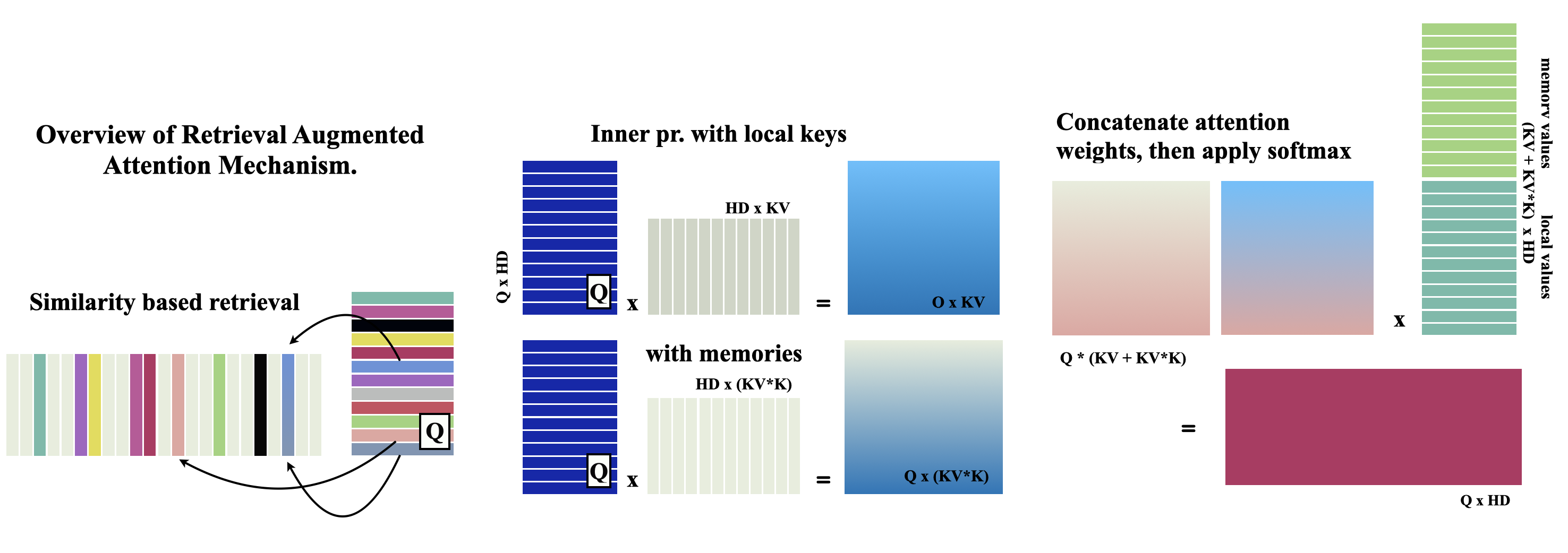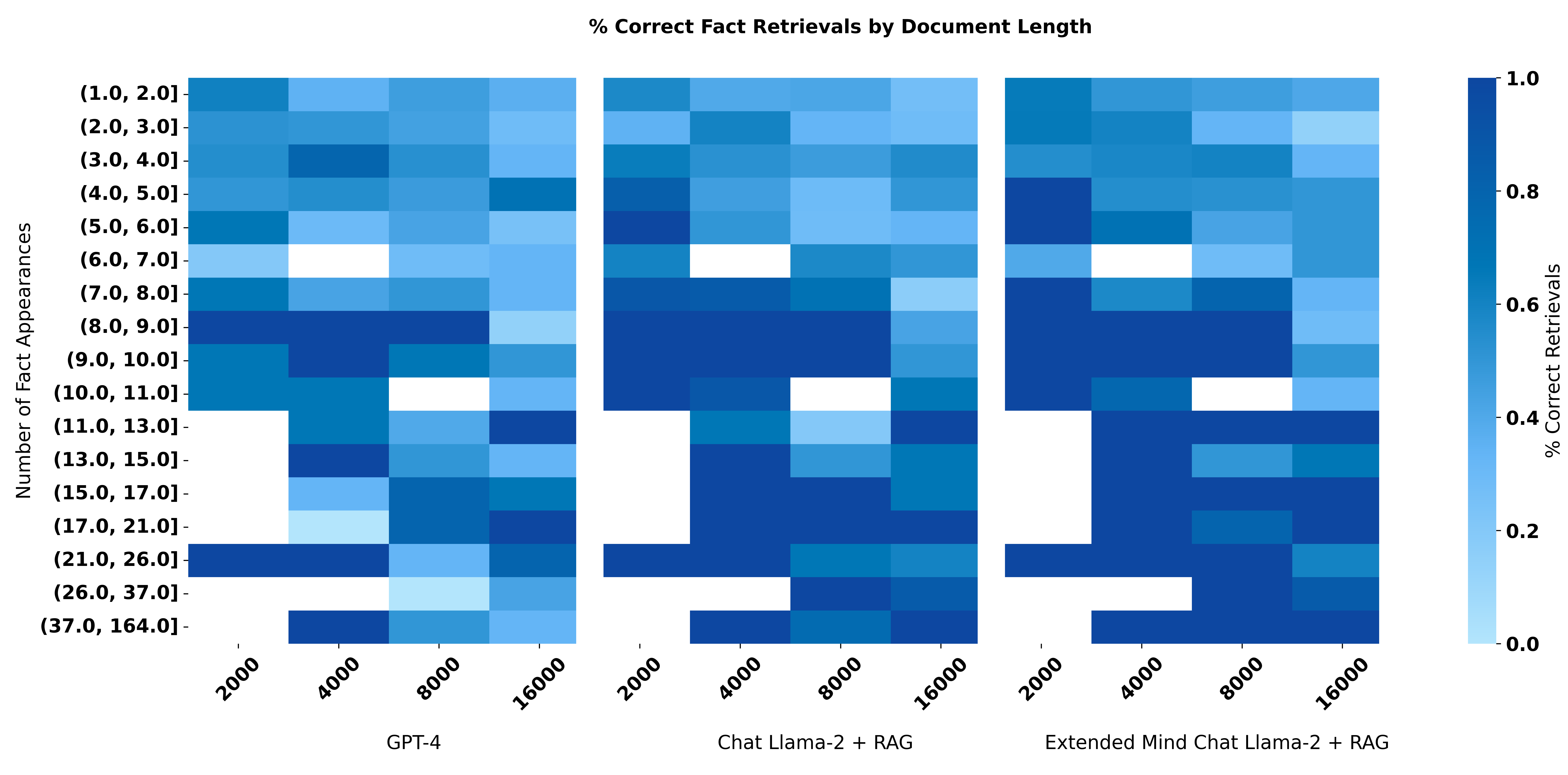This is the official implementation of Extended Mind Transformers. We open-source a collection of Extended Mind Transformers, as well as a new counterfactual long-range benchmark.
We present Extended Mind Transformers, a variety of decoder-only transformers closely related to Memorizing Transformers (Wu et al. 2022) that retrieve and attend to an external cache of key-value pairs (or memories) without finetuning. The model decides for each token, within a particular decoder, which memories are important. The complete collection of Extended Mind Transformers includes:
Extended Mind Llama2
Llama-2-7B | Chat Llama-2-7B | Llama-2-70B | Chat Llama-2-70B
Extended Mind MPT
Passing external memories to the model is easy. Simply pass the token ids to the model during instantiation, as the following examples illustrate. Generating and caching the memories is handled internally, during the first model.generate() call. You can update the memories using the following sequence of commands:
model.clear_memories()
model.memory_ids = list_of_new_token_idsThe retrieval-augmentation we introduce to the self-attention mechanism is quite straightforward. In addition to self-attention, we introduce top-k attention (Gupta et al. 2021) over the cached key-value pairs. I.e., we allow each query token to attend to a certain number of external key-value pairs where the cosine similarity between the query and key is largest. The retrieval-augmented attention mechanism can be described by the following equations:
scores =
where
The following figure provides a visual aid for how self-attention is combined with top-k attention over external memories.
- Install conda as specified here: https://docs.anaconda.com/free/miniconda/#quick-command-line-install
- Create Environment:
conda create --name emt_env python=3.11 - Activate Environment:
conda activate emt_env - Install packages:
python -m pip install -r requirements.txt
Everything should run from root: PYTHONPATH=. python
Run experiments/data/wikiqa-edit.py to download and preprocess the WikiQA dataset.
Load any of the above models with the usual huggingface .from_pretrained() method. Since we use custom modeling code, set trust_remote_code=True to avoid warnings. Pass the memories to the model as a list of token ids.
from transformers import AutoModelForCausalLM, AutoTokenizer
ag_wiki_entry = """Alexander Grothendieck (/ˈɡroʊtəndiːk/; German pronunciation: [ˌalɛˈksandɐ ˈɡʁoːtn̩ˌdiːk] (listen); French: [ɡʁɔtɛndik]; 28 March 1928 – 13 November 2014) was a stateless (and then, since 1971, French) mathematician who became the leading figure in the creation of modern algebraic geometry.[7][8] His research extended the scope of the field and added elements of commutative algebra, homological algebra, sheaf theory, and category theory to its foundations, while his so-called "relative" perspective led to revolutionary advances in many areas of pure mathematics.[7][9] He is considered by many to be the greatest mathematician of the twentieth century.[10][11]"""
tokenizer_hf = AutoTokenizer.from_pretrained("normalcomputing/extended-mind-llama-2-7b")
memories = tokenizer_hf(ag_wiki_entry).input_ids
model_hf = AutoModelForCausalLM.from_pretrained("normalcomputing/extended-mind-llama-2-7b", external_memories=memories, trust_remote_code=True)After this, you can generate text with the model as usual. The model will automatically use the memories during generation. You can update any config parameters (we set topk below) by passing new values to the model.generate() method.
inputs = "When did Alexander Grothendieck become a French citizen?"
inputs = tokenizer(inputs, return_tensors="pt").input_ids
outputs = model.generate(inputs, max_length=40, topk=2)
tokenizer.decode(outputs_hf['sequences'][0], skip_special_tokens=True)By simply setting output_retrieved_memory_idx=True in the model.generate() method, you can retrieve the memory indices used during generation. We walk through an example in the demo notebook.
LongLLaMA has several other parameters:
memory_type(string, optional, defaults tomanual): Whether to store external memories manually or in a vector database.mask_by_sim(bool, optional, defaults toTrue): Whether or not to mask retrieved memories by similarity.sim_threshold(float, optional, defaults to0.25): Threshold for masking retrieved memories.tokenizer_all_special_ids(list, optional, defaults to[0, 50278]): Ids for special tokens to remove from memories.remove_special_tokens(bool, optional, defaults toTrue): Remove memories that correspond to tokenizer special ids.
Additionally, the stride used to compute the memory representations can be set within generate_cache() method. Smaller strides generate higher-quality representations, while larger strides require fewer computations.
Experiments should be run using the pattern:
PYTHONPATH=. python /path/to/run_experiment.py --base /path/to/config.yaml
Example:
PYTHONPATH=. python ./experiments/run_retrieval.py --base ./experiments/configs/extended-llama-retrieval-70b.yaml
If running OpenAI models (including embeddings for RAG), run this from your terminal first:
export openai_key="your_key_here"
export openai_org="your_org_here"
Our new benchmark is a modified wikiQA benchmark, which can be accessed here. The dataset is composed of Wikipedia articles (of 2-16 thousand tokens) and corresponding questions. We modify the dataset by changing the labeled answers to realistic but wrong answers, to control for facts memorized during pre-training. For example, we replace every instance of "Lee Hazlewood" with "Terry Allen" in the Wikipedia entry for the song "These Boots Were Made For Walking", and then ask the model to produce the songwriter's name, with the correct answer now being "Terry Allen". More detail on the dataset creation can be found in the paper.
We summarize the performance of Extended Mind Transformers on our long-range counterfactual retrieval benchmark. Extended Mind Transformers are competitive with fine-tuned models on long inputs, and outperform them on short inputs. Extended Mind Transformers combined with RAG outperform GPT-4 by a large margin,

|

|
| Model | 2k | 4k | 8k | 16k |
|---|---|---|---|---|
| 7b models | ||||
| Extended Mind Chat Llama2-7b | 38.59% | 37.95% | 36.00 % | 33.54% |
| Chat Llama2 | 42.74% | 41.96% | 33.50% | 17.68% |
| Noushttps://huggingface.co/NousResearch/Yarn-Llama-2-7b-64k | 34.85% | 35.71% | 37.50% | 33.54% |
| Together AI | 37.34% | 40.63% | 37.00% | 36.59% |
| 70b+ models | ||||
| Extended Mind Chat Llama2-70b + RAG | 59.34% | 53.13% | 53.00% | 50.00% |
| Chat Llama2-70b + RAG | 50.21% | 47.32% | 44.50% | 45.12% |
| GPT-4 | 52.28% | 50.00% | 46.00% | 43.29% |
We can also stratify the results by the number of times the fact appears in the document. In this plot, each cell represents samples where the number of fact appearances falls within the range specified on the x-axis, and is colored to represent the overall success of the retrievals. The results are further stratified by sequence length, on the y-axis. Intuitively, if the fact appears many times, it should be easier to retrieve.
To cite this work please use
@misc{klett2024extended,
title={Extended Mind Transformers},
author={Phoebe Klett and Thomas Ahle},
year={2024},
eprint={2406.02332},
archivePrefix={arXiv},
primaryClass={cs.LG}
}Our source code is liscensed under Apache License, Version 2.0. The models and dataset are for research purposes only. Our source code is based on code written by teams at Meta and Mosaic ML, and inherits their liscenses as specified in the code. We annotate where changes have been made.


